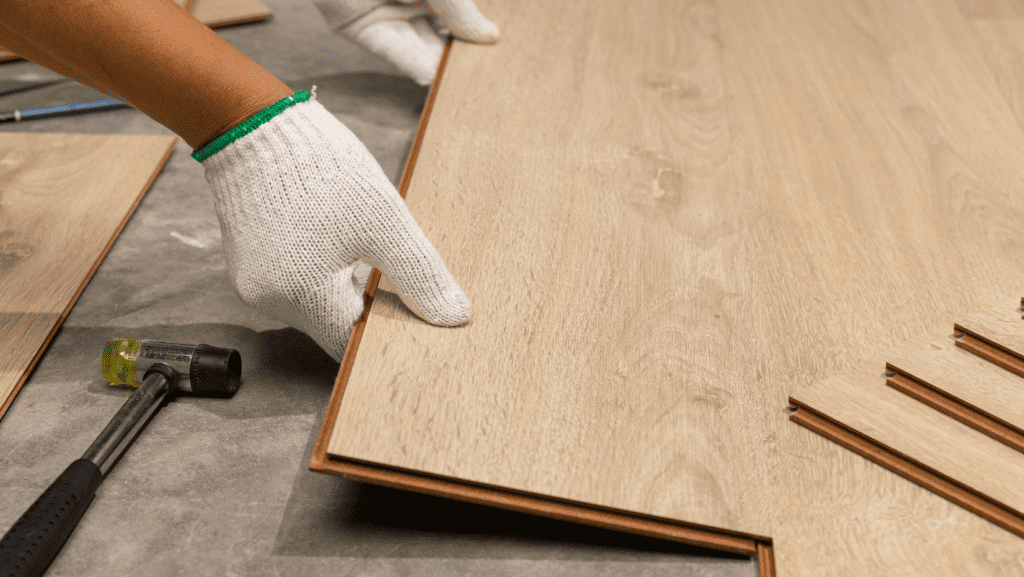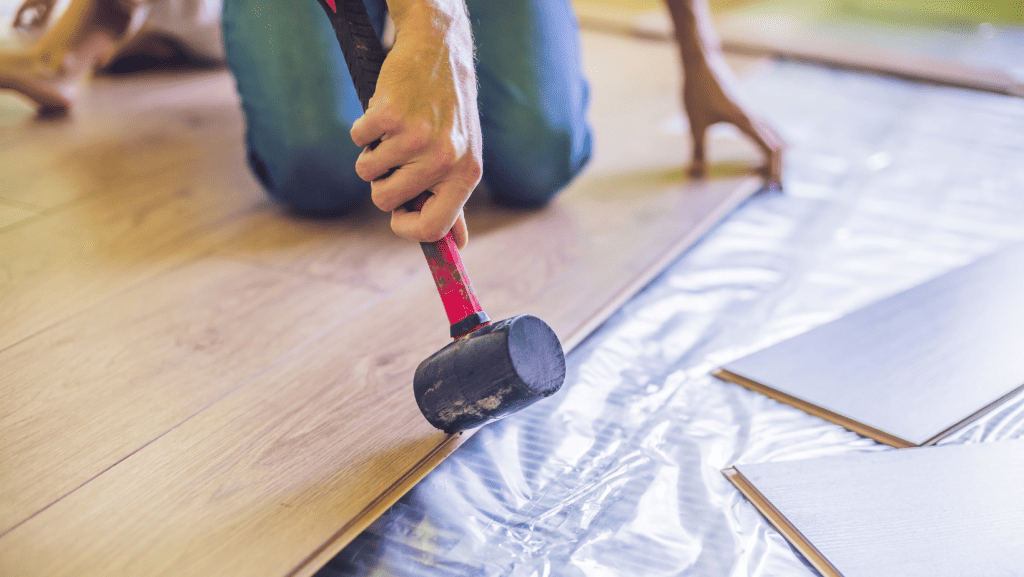Laying a laminate floor is a high-pressure task. I want to be on my hands and knees for as long as possible, so I don’t want to make any mistakes.
Recently, I spent 2 knee-bruising weeks of floor laying in my living room. It was tough, and the wife was away, so I had nobody inspecting my work or to help me off the floor.
Table of Contents
The project wasn’t without its errors, and to give you a head start, I’ve documented the most common mistakes when laying laminate flooring below so you don’t make the same mistakes I did.
By avoiding these, you can lay your laminate flooring with peace of mind, and it will go as efficiently as possible. As a result, your floor will look great.
The 9 Most Common Mistakes When Laying Laminate Flooring
Let’s face it: Multiple things can go wrong during any project. The following are the most common errors you can encounter when attempting to attack your laminate flooring.
Neglecting the Edge Expansion Gap
You must recognise the importance of creating an edge expansion gap around your room’s perimeter. Overlooking this step was the first common mistake I unfortunately made.
The UK weather is rather unpredictable, and the humidity and temperature can affect the wood’s size and structure before it settles.
When laid, laminate flooring needs enough room to expand and contract. The flooring will buckle and distort over time without the edge expansion gap. You must give your laminate floor the breathing room to withstand UK conditions.
Make Sure Your Subfloor Is Level
You want to avoid sagging, soft spots, or irregular bumps in your laminate flooring. Before you start laying your floor, make sure to prep the subfloor.
The tolerance should not exceed 1/8 of an inch. If you need to do some prep work to get your subfloor where it needs to be, use grinding, sanding, and applying self-levelling material.
Using The Wrong Tools
Another common mistake when laying laminate flooring is not using the right tools during installation. Using the wrong tools will complicate the process and risk damaging the boards. Here are the essentials that will make your life easier than mine:
1. Power saw: A fine-tooth jigsaw tool ensures clean and precise cuts, preventing chipping.
2. Pull bar/Clamp: Tighten boards for a snug fit during installation.
3. Tapping block: Gently tap planks into place without causing damage.
4. Spacers: Maintains the expansion gap and ensures consistent board width.
Trust me, it’s not fun when you’re not equipped for the job. Always invest in the right tools. It certainly contributes to achieving a professional-looking result.

Skipping the Acclimation Time
Before installing wood flooring in your home, it’s important to let it acclimate. This helps prevent warping and buckling by allowing the wood to adjust to your home’s humidity levels.
Typically, it would help if you let the flooring planks acclimate for 48-72 hours, following the instructions on the box.
Skipping this step can lead to buckling or unsightly gaps in your laminate flooring.
Leaving Your Floor Unfinished
Not actually completing the finishing touches to your flooring is always a mistake that can happen due to life getting in the way.
Leaving things like transitions or mouldings incomplete can make your new laminate flooring look scruffy. Make sure to finish it, including those last little annoying jobs.
Not using an Underlay.
The laminate flooring underlay is super important to lay during the installation process. Skipping the underlay will almost certainly cause issues down the road.
Laminate flooring is a floating floor, meaning it’s not attached to the subfloor. This can lead to some movement over time, especially if there’s any moisture involved.
That’s where the underlayment comes in—it helps stability and keeps your floor from going wonky.
Installing Your Floor in the Wrong Direction
The direction in which your flooring is laid certainly impacts the overall appearance of your space. Installing it in the wrong direction will not look right to the eye.
Consider the room’s primary natural light source when deciding how you want the floor to run. Installing the planks parallel to the light source creates a sense of expansiveness.
Installing them perpendicular to the floor joists is also recommended for stability.
Take the time to carefully consider the orientation of the laminate. It can make a significant difference in the final outcome.
It’s a small detail that plays a significant role in shaping the overall look and feel of the room.
Not Cleaning the Subfloor
I quickly realised how important a clean subfloor is for a successful installation.
Debris on the subfloor can prevent the laminate boards from joining together properly, resulting in the nightmare of squeaky or loose flooring.
To avoid this, make it a point to properly clean the subfloor before installing the floor.
I got a hoover and hoovered the dirty floor before beginning the installation. If any tenacious stains remain, go the extra mile and clean the subfloor with a light detergent and warm water.
Always let it dry completely before beginning the installation. This quick pre-installation cleanup ensures a good job.
Neglecting Good Aftercare
The last common mistake when laying laminate flooring is neglecting proper maintenance.
This is key to its longevity and appearance. Here are some of my essential tips to stay on top of the quality:
1. Regularly sweep or vacuum to remove dirt.
2. Quickly clean up spills with a damp mop or microfiber cloth.
3. Be cautious with moisture, as laminate isn’t waterproof.
4. Use furniture pads to prevent scratches and dents.
5. Avoid wearing high heels to prevent surface damage.
Following these tips (especially the last one) will help keep your laminate looking great for years.
Avoiding these common mistakes when laying laminate flooring will ensure the process remains as efficient as possible and you don’t spend any more time than necessary on your hands and knees.

The Most Common Mistakes When Laying Laminate Flooring FAQ's
Yes, there are several common mistakes when laying laminate flooring. Common problems include:
- Improper subfloor preparation.
- Not allowing your floor to acclimatise
- Failure to use expansion spacers.
These blunders can cause warping, buckling, and gaps in your flooring. To avoid these issues, follow the manufacturer’s directions carefully and ensure the subfloor is clean and level before installation.
Yes, the starting location for your laminate flooring installation is essential. It’s best to start with the longest, straightest wall, usually the one you see first when you walk into the room.
This procedure ensures that the planks are put evenly and avoids the need for cuts. Starting in the proper spot also contributes to the flooring’s visual flow and structural stability.
One of the most common mistakes when laying laminate flooring is when moisture damage frequently occurs. Laminate is not waterproof, so excessive water might cause it to bloat, warp, or grow mould.
To avoid this, clean up spills quickly, use a damp—not wet—mop for cleaning, and avoid placing laminate in high-moisture locations such as restrooms.
If the problems still persist, get advice from a flooring specialist.
Yes, you should always stagger the laminate flooring planks. Staggering improves the floor’s appearance and adds stability.
Aligning the ends of the boards can result in weak places, causing structural concerns and rendering the floor susceptible to separation. A staggered pattern distributes weight and pressure more evenly, which extends the life of your flooring.
To maintain laminate flooring properly, sweep or hoover it regularly to remove dirt and debris, clean it with a moist mop, and avoid using too much water. Because laminate is not waterproof, exercise caution when dealing with moisture.
Use furniture pads to prevent scratches and dents, and avoid wearing high heels to protect the surface. Follow these maintenance suggestions to keep your laminate flooring looking excellent for years.
To install laminate flooring, you’ll need a tape measure, a utility knife, a laminate floor cutter or saw, spacers, a tapping block, a rubber mallet, and safety equipment such as gloves and goggles.
These tools will help you correctly measure, cut, and secure the planks, resulting in a seamless installation process.
Yes, laminate flooring can be laid over existing floors, such as vinyl, tile, or hardwood, as long as the subfloor is clean, dry, and level.
Follow the manufacturer’s underlayment and other preparation requirements to guarantee a successful installation.
Common Mistakes When Laying Laminate Flooring
Thank you for reading our article on the most common mistakes when laying laminate flooring. If you found it useful, please head over to our blog HERE, for more DIY tips and advice tailored for dads.






